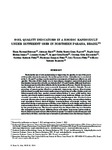Por favor, use este identificador para citar o enlazar este ítem:
http://www.alice.cnptia.embrapa.br/alice/handle/doc/984910| Título: | Soil quality indicators in a rhodic kandiudult under different uses in northern Parana, Brazil. |
| Autor: | KUWANO, B. H.  KNOB, A.   FAGOTTI, D. S. L.   MELEM JUNIOR, N. J.   GODOY, L.   DIEHL, R. C.   KRAWULSKI, C. C.   ANDRADE FILHO, G.   ZANGARO FILHO, W.   TAVARES FILHO, J.   NOGUEIRA, M. A.   |
| Afiliación: | BIANA HARUMI KUWANO, Universidade Estadual de Londrina ADRIANA KNOB, Universidade Estadual de Londrina DÁFILA SANTOS LIMA FAGOTTI, Universidade Estadual de Londrina NAGIB JORGE MELEM JUNIOR, CPAF-AP LEANDRO GODOY, Universidade Estadual de Londrina RAQUEL CÁTIA DIEHL, Universidade Estadual de Londrina CRISTINA CÉLIA KRAWULSKI, Universidade Estadual de Londrina GALDINO ANDRADE FILHO, Universidade Estadual de Londrina WALDEMAR ZANGARO FILHO, Universidade Estadual de Londrina JOÃO TAVARES-FILHO, Universidade Estadual de Londrina MARCO ANTONIO NOGUEIRA, CNPSO. |
| Año: | 2014 |
| Referencia: | Revista Brasileira de Ciência do Solo, Viçosa, MG, v. 38, p. 50-59, 2014. |
| Descripción: | Sustainable use of soil, maintaining or improving its quality, is one of the goals of diversification in farmlands. From this point of view, bioindicators associated with C, N and P cycling can be used in assessments of land-use effects on soil quality. The aim of this study was to investigate chemical, microbiological and biochemical properties of soil associated with C, N and P under different land uses in a farm property with diversified activity in northern Parana, Brazil. Seven areas under different land uses were assessed: fragment of native Atlantic Forest; growing of peach-palm (Bactrys gasipaes); sugarcane ratoon (Saccharum officinarum) recently harvested, under renewal; growing of coffee (Coffea arabica) intercropped with tree species; recent reforestation (1 year) with native tree species, previously under annual crops; annual crops under no-tillage, rye (Cecale cereale); secondary forest, regenerated after abandonment (for 20 years) of an avocado (Persea americana) orchard. The soil under coffee, recent reforestation and secondary forest showed higher concentrations of organic carbon, but microbial biomass and enzyme activities were higher in soils under native forest and secondary forest, which also showed the lowest metabolic coefficient, followed by the peach-palm area. The lowest content of water-dispersible clay was found in the soil under native forest, differing from soils under sugarcane and secondary forest. Soil cover and soil use affected total organic C contents and soil enzyme and microbial activities, such that more intensive agricultural uses had deeper impacts on the indicators assessed. Calculation of the mean soil quality index showed that the secondary forest was closest to the fragment of native forest, followed by the peach-palm area, coffee-growing area, annual crop area, the area of recent reforestation and the sugarcane ratoon area. |
| NAL Thesaurus: | land use microbial biomass soil quality soil enzymes |
| Palabras clave: | Bioindicadores Biomassa microbiana Coeficiente metabólico Enzimas do solo Qualidade do solo Uso do solo Bioindicators Metabolic coefficient |
| Tipo de Material: | Artigo de periódico |
| Acceso: | openAccess |
| Aparece en las colecciones: | Artigo em periódico indexado (CPAF-AP)  |
Ficheros en este ítem:
| Fichero | Descripción | Tamaño | Formato | |
|---|---|---|---|---|
| CPAFAP2014Soilquality.pdf | 199,12 kB | Adobe PDF |  Visualizar/Abrir |









